This Door knob Coat rack is a hand-crafted one-of-a-kind piece made from materials with an interesting back-story.
The door knobs we’ve used in this piece were first seen in the early 1800s. We know that that they were original to the Cambridge, MA home that we got them from. The metal shanks are made of cast iron, and the base of the knobs are made of brushed brass. They’re known as “mineral knobs”, which are natural glacial clay that have a “Albany slip” glaze or a clear glaze composed of feldspar and flint.
The clays found around the Albany NY area were a natural glacial clay with a high iron content, and were used extensively in the early 1800s pottery industry. The “Albany slip” glaze would enhance the color of the material and sealed the rough body texture caused by the drying clays after they were formed to their desired shape.
Another glazing method used a clear glaze of composed mainly of feldspar and flint, and this would permit the marble-like swirls of the various clays used in the knob body to show through. So it is easy to mistake this naturally derived product for genuine marble.
The wood used in this piece is among the hardest and most stiff of the woods in the world. It’s called Purpleheart Wood. And it’s simply beautiful. Truth be told, we’ve actually fallen for this wood, and plan to use it more frequently in the future! So, why are we hooked?
Aside from general appearance and feel, the flowering trees (called Peltogyne, known as Purpleheart or Amaranth) are native to the rain forests of Brazil, Guyana, and Suriname.
The trees are prized for their beautiful heartwood which, when cut, quickly turns from a light brown to a rich purple color. Exposure to ultraviolet (UV) light darkens the wood to a brown color with a slight hue of the original purple. The longer the wood is exposed to UV lights (sunlight), the colour of purple slowly changes from a light purple to a substantially chocolate-purple colour.
This beautiful wood is commonly used in cabinetry, flooring, furniture, and for guitar and musical instrument inlays. We had to take special precaution when working with this wood, as exposure to the dust generate during cutting and sanding causes nausea and irritation. It also emits a resin that is extremely damaging to our machinery, and is easily burned if cut improperly.
Moderately hard to work but takes a glossy, lustrous finish. Lacquer finish will best preserve the color.
But, even with all of the challenges we have faced with Purpleheart Wood, we were quick to reap our reward when we began to see the finished piece emerge. It truly is the smoothest wood we’ve even laid our hands on. And the color is quite breathtaking. It’s not something you see everyday, and it’s sure to grab someone’s attention.
This multi-functional piece can be used in many creative ways. Sure, you could hang it horizontally and use it as a coat rack. Or you could hang it vertically as a stand-alone show piece. Perhaps our favorite way is to hang it horizontally to display your family photos like Jennifer from Pin or Pass did below. We love the ribbons, and even love the idea of “stacking” photos, so they hang vertically.
via Pin or Pass: A Fun Way to Hang Your Picture Frames.
This piece comes with full mounting hardware, although as with every piece we create, we offer local installation. The Door Knob Coat Rack measures 36″ long, 3″ wide, and 3/4″ thick.


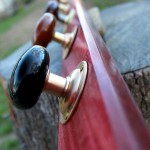
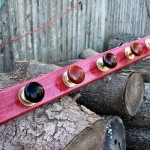
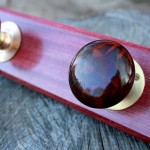
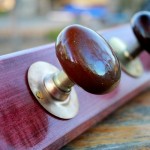
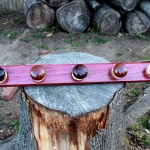
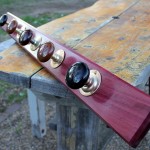
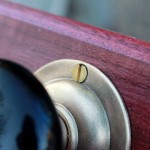
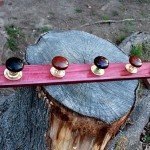
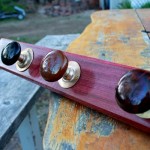
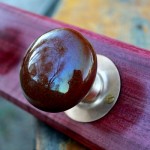
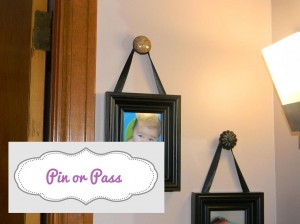
Recent Comments